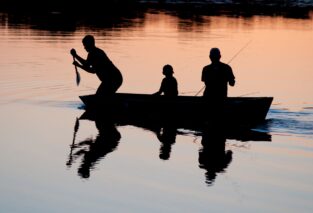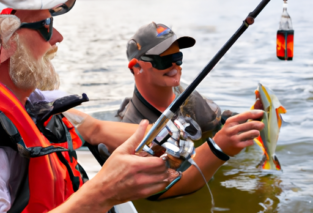Are you a passionate bass fisherman wondering if you can still indulge in your favorite hobby during the winter months? Look no further! The “Can You Go Bass Fishing in Winter: Essential Tips and Techniques” is the perfect guide for you. Packed with invaluable information and expert advice, this comprehensive resource will equip you with the necessary know-how to successfully catch bass even in the colder seasons. From gear recommendations to fishing techniques specifically tailored for winter conditions, this guide has got you covered. So don’t let the chilly weather deter you from your bass fishing adventures – with these essential tips and techniques, you can continue pursuing your passion all year round!
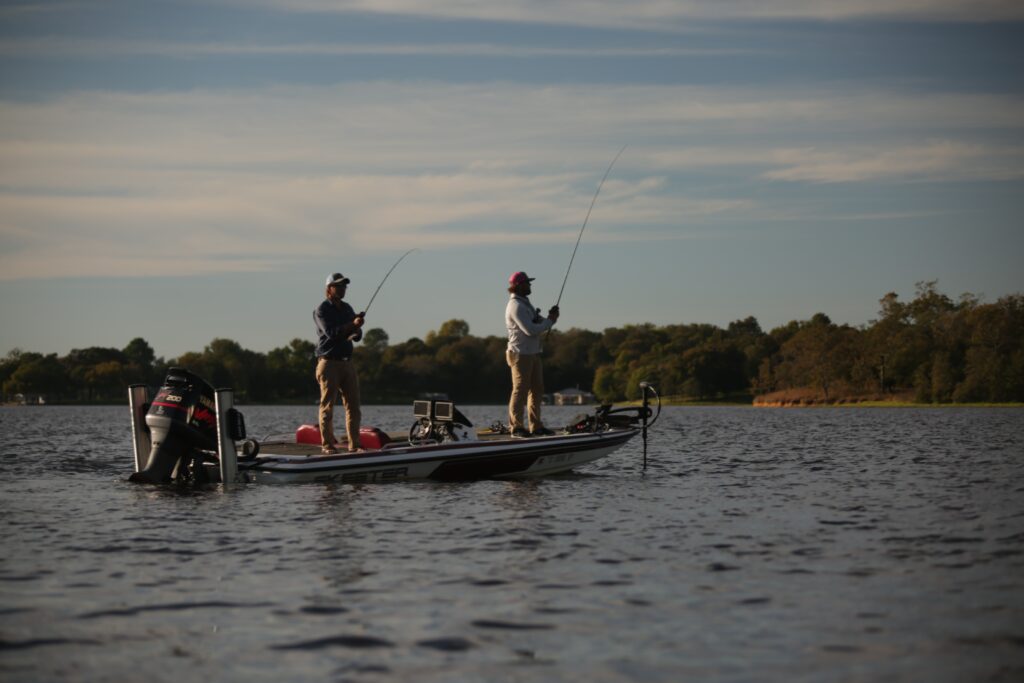
Choosing the Right Location
Researching potential fishing spots
When it comes to winter bass fishing, choosing the right location is crucial. Start by researching potential fishing spots in your area. Look for lakes, rivers, or reservoirs known for their bass population. Utilize local fishing forums, social media groups, and online fishing resources to gather information on the best spots for winter bass. Take note of recommendations from experienced anglers who have had success in these locations.
Considering water temperature
Water temperature plays a significant role in bass behavior during the winter months. Bass are cold-blooded creatures, and their metabolism slows down as water temperature drops. Look for areas with water temperatures slightly higher than surrounding waters. Shallow areas exposed to direct sunlight, such as rocky shores or shallow coves, tend to have slightly warmer water. These areas can attract bass seeking slightly warmer temperatures.
Identifying areas with structure
Bass seek out areas with structure for shelter, ambush points, and feeding opportunities. Look for spots with rocky structures, fallen trees, submerged vegetation, or man-made structures such as docks or piers. These structures provide hiding spots and attract smaller fish, which in turn attract bass. Additionally, areas with structure offer more cover and provide breaks in the current, making it easier for bass to conserve energy.
Looking for areas with food sources
Bass in winter are less active and tend to conserve energy. Therefore, they look for areas with abundant food sources. Look for signs of baitfish activity, such as jumping or splashing on the water’s surface. Pay attention to areas with submerged vegetation, as they provide cover for small aquatic insects and other organisms that serve as a food source for bass.
Exploring different depths
Bass may be found at different depths during the winter months, depending on factors such as water temperature, food availability, and oxygen levels. Start by exploring shallow areas and gradually work your way to deeper waters. Use a fish finder or depth gauge to determine the depth at which bass are most active. By exploring different depths, you increase your chances of finding bass in their preferred feeding zones.
Selecting the Right Gear
Using appropriate fishing rods
Choosing the right fishing rod is essential for winter bass fishing. Opt for a medium-heavy to heavy action rod with a sensitive tip. The sensitive tip allows you to detect subtle bites, while the sturdier backbone helps you effectively set the hook and handle larger bass. Additionally, consider using a shorter rod, around 6 to 7 feet in length, for improved control and accuracy when fishing in tighter spaces or around structure.
Choosing the right fishing line
Selecting the right fishing line is crucial to ensure a successful winter bass fishing experience. Fluorocarbon lines are popular choices for winter fishing due to their low visibility and high sensitivity. They also have less line memory, allowing for better lure presentation. Consider a line between 8 to 12-pound test for optimal performance. However, adjust the line strength according to the size of bass you expect to encounter in the chosen location.
Selecting the right hooks
Choosing the right hooks when winter bass fishing can make a significant difference in your success rate. For most winter fishing situations, opt for light wire, wide gap hooks. These hooks provide better hook penetration, especially when bass have a more subtle bite. Additionally, consider using a straight shank or offset shank hook, depending on your bait choice and fishing technique.
Using the right bait and lures
Selecting the right bait and lures is crucial for enticing bass to bite during the winter months. Choose baits and lures that imitate the natural prey of bass, such as shad, crawfish, or smaller baitfish. Jigging spoons, blade baits, jerkbaits, and soft plastics are proven options for winter bass fishing. Experiment with different colors and sizes to determine what the bass in your chosen location are most likely to respond to.
Using specialized winter fishing gear
In some cases, using specialized winter fishing gear can significantly improve your chances of success in landing bass. Look into investing in ice fishing gear, such as ice augers, ice shelters, and portable sonar units. Ice fishing gear allows you to fish on frozen lakes or ponds where bass may still be active. Consider using tip-ups or tip-downs to cover multiple holes simultaneously, increasing your chances of landing a winter bass.

Understanding Bass Behavior in Winter
Learning about bass metabolism
Understanding bass metabolism is crucial for successful winter bass fishing. As the water temperature drops, bass’ metabolism slows down, resulting in reduced activity levels. This means they require less food to sustain themselves during the winter months. Adjust your fishing techniques accordingly, as bass are more likely to exhibit slower and more hesitant feeding behavior.
Understanding their feeding patterns
Winter bass feeding patterns differ from those during other seasons. Bass become more opportunistic feeders, relying on slower-moving prey due to their reduced activity levels. They tend to feed in short bursts and conserve energy by targeting easy meals. This change in feeding behavior means you need to be patient and present your bait or lure in a slow and methodical manner to entice a bite.
Identifying their preferred hiding spots
Bass seek out specific hiding spots during the winter months to conserve energy and protect themselves from harsh conditions. Look for areas with ample cover, such as submerged vegetation, fallen trees, or rocky structures. Bass may also hide near sharp drop-offs or deep holes where they can find more stable water temperatures. By identifying their preferred hiding spots, you can increase your chances of locating and catching winter bass.
Taking note of their activity levels
Winter bass are less active than during other seasons, and their behavior can vary depending on the specific conditions on any given day. Observe the water for any signs of bass activity, such as surface disturbances or the presence of baitfish. Take note of any changes in their behavior, as this can help you adjust your fishing techniques accordingly. Remember, patience and adaptability are key when targeting winter bass.
Recognizing their reaction to changes in weather
Bass can exhibit different behavior patterns in response to changes in weather conditions during the winter months. For example, a sudden drop or rise in temperature can trigger temporary bursts of feeding activity. Similarly, changes in barometric pressure can affect their feeding behavior. Pay attention to changing weather patterns and adjust your fishing tactics accordingly to maximize your chances of success.
Techniques for Winter Bass Fishing
Slow and steady retrieves
During winter bass fishing, slow and steady retrieves are key to enticing bites. Bass have reduced activity levels and may not be willing to chase after fast-moving prey. Use a slow and consistent retrieval speed to present your bait or lure in a way that mimics the slow movements of their natural prey. This technique allows bass more time to assess the bait and increases the chances of a bite.
Jigging and hopping techniques
Jigging and hopping techniques are effective ways to trigger strikes from winter bass. Use a jigging motion to make your lure imitate a dying or injured baitfish. Lift your rod tip slightly and then allow the lure to fall back down, creating an enticing movement. This technique can be particularly effective when fishing around submerged structure or drop-offs where bass may be hiding.
Drop-shotting
Drop-shotting is a popular technique for winter bass fishing that allows for precise bait presentation. Rig your drop shot with a finesse worm or small plastic bait and use a slow, subtle movement to entice bites from sluggish bass. The drop-shot rig keeps your bait suspended above the bottom, making it easier for bass to target without expending much energy.
Deadsticking
Deadsticking is a technique that involves minimal bait movement to entice bites from winter bass. Cast your bait near potential hiding spots or structure and allow it to sit still for an extended period. This technique mimics natural prey that may be motionless, making it an attractive target for bass. Stay patient and be prepared for subtle bites as bass may take their time to inspect and commit to the bait.
Twitching and pause techniques
Twitching and pause techniques can be effective for triggering bites from winter bass. Use baits or lures that provide a subtle side-to-side action with a twitch or slight jerk of your rod tip. After twitching the bait, allow it to pause and sink slowly to imitate a struggling or injured prey. This technique can be particularly effective when targeting bass near cover or structure.
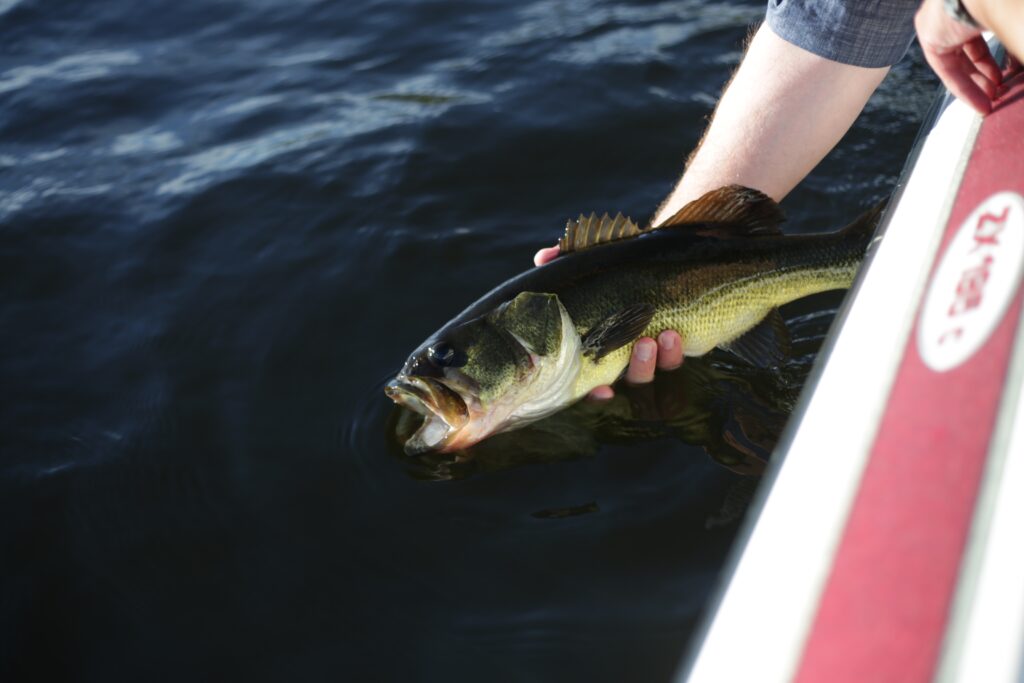
Importance of Patience and Persistence
Being patient with slower bites
One of the most important aspects of winter bass fishing is practicing patience, especially when dealing with slower bites. Bass have reduced activity levels during the winter months and may not be as actively feeding as during other seasons. Don’t get discouraged if the bites are slow; instead, remain patient and persistent with your fishing techniques. Remember, a slow bite can quickly turn into a feeding frenzy.
Sticking to one spot for longer periods
Winter bass fishing often requires spending more time in one spot compared to other seasons. Bass may be less active and more reluctant to move for a meal. Give yourself ample time to thoroughly fish an area before moving on to a new spot. Sometimes, all it takes is a little extra persistence to land that elusive winter bass.
Testing different techniques and baits
Winter bass fishing requires adapting to the changing conditions and the preferences of the fish. Be open to experimenting with different fishing techniques and baits. If a particular technique or bait isn’t producing results, switch things up and try something new. Testing different techniques and baits increases your chances of success and allows you to learn more about what works best in different winter fishing scenarios.
Adapting to changing conditions
Weather and water conditions can change rapidly during the winter months. Adapting to these changes is crucial for successful bass fishing. Keep an eye on weather forecasts and adjust your fishing strategies accordingly. If a bright sunny day suddenly turns overcast, consider switching from slow-moving techniques to more aggressive presentations to capitalize on the change in bass behavior.
Keeping a positive mindset
Maintaining a positive mindset while winter bass fishing is essential. Challenging conditions, slow bites, and the need for patience may test your resolve. However, staying positive and confident in your abilities will improve your overall experience. Remember, winter bass fishing offers unique opportunities and rewards that make the effort worthwhile.
Adapting to Various Weather Conditions
Fishing during clear and sunny days
Clear and sunny days can present their own challenges when winter bass fishing. Bass may be less inclined to move and feed actively in bright sunlight. During these conditions, focus on fishing in deeper waters or near shaded areas, such as submerged structures or overhanging vegetation. Utilize darker-colored baits or lures that mimic the silhouette of natural prey.
Fishing on cloudy and overcast days
Cloudy and overcast days can have a positive impact on winter bass fishing. Bass may be more active and willing to venture into shallower waters during these conditions. Take advantage of reduced sunlight penetration by fishing in shallow areas, especially near potential feeding zones. Experiment with a variety of bait colors to find what works best, as bass may respond differently to varying levels of visibility.
Fishing during rain or snowfall
Fishing during rain or snowfall can yield excellent results for winter bass fishing. These weather conditions can trigger increased feeding activity and mask your presence due to the extra noise and disturbance in the water. Focus on fishing near shallow areas, as rain or snowfall may wash insects or small creatures into the water, attracting bass. Consider using brighter-colored lures or baits to improve visibility.
Adjusting strategies for windy conditions
Wind can have a significant impact on winter bass fishing. Strong winds can create current and stir up the water, making it difficult for bass to locate or ambush prey. During windy conditions, focus on fishing in areas that provide shelter from the wind, such as coves, sheltered bays, or the leeward side of the lake. Adjust your bait presentation to account for increased water movement and aim for more aggressive techniques.
Knowing when it’s safe to fish in winter
While winter bass fishing can be rewarding, it’s essential to prioritize safety. Before venturing out, familiarize yourself with local ice conditions and ensure they are safe for fishing. Follow ice thickness guidelines and carry ice picks, a safety rope, and a life jacket to mitigate the risk of falling through thin ice. Additionally, be mindful of slippery conditions on shorelines and use caution while navigating potential hazards.
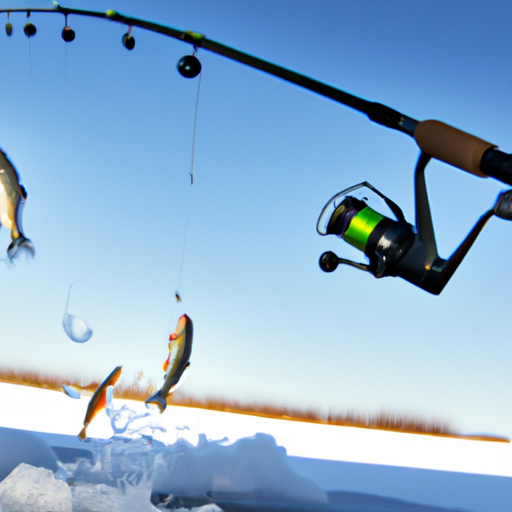
Safety Precautions for Winter Bass Fishing
Dressing in appropriate clothing layers
When fishing in winter, dressing in appropriate clothing layers is crucial for staying warm and comfortable. Layering allows you to adjust your clothing based on changing weather conditions and activity levels. Start with a moisture-wicking base layer to keep sweat away from your body. Add insulating layers such as fleece or down jackets for warmth and finish with a waterproof and windproof outer layer to protect against the elements.
Using ice cleats for improved traction
Walking on ice can be challenging and slippery. Investing in ice cleats or traction devices for your boots is essential for maintaining stability and preventing falls. Ice cleats provide additional grip on icy surfaces, reducing the risk of injury. Ensure the ice cleats fit securely on your boots to ensure maximum effectiveness.
Carrying necessary safety equipment
Carrying necessary safety equipment is crucial for winter bass fishing. Always have a first aid kit readily available in case of any emergencies or injuries. Additionally, carry a whistle or other noise-making devices to attract attention if needed. Keep a mobile phone in a waterproof case for communication and emergency purposes. Being prepared with the right safety equipment can make a significant difference in case of unforeseen circumstances.
Being aware of potential ice hazards
When fishing on frozen lakes or ponds, it’s essential to be aware of potential ice hazards. Stay clear of areas with open water or moving currents as the ice may be thinner or weaker. Be cautious around ice cracks, pressure ridges, or areas with snow-covered ice, as these can indicate potential hazards. By staying vigilant and being aware of your surroundings, you can minimize the risk of accidents on the ice.
Informing others about your fishing plans
Informing others about your fishing plans is an important safety measure, especially when fishing alone. Let a family member, friend, or fellow angler know your fishing location, estimated return time, and any specific details they may need to know in case of an emergency. This information ensures that someone can raise the alarm or provide assistance if you encounter any difficulties.
Tips for Catch and Release in Winter
Using non-invasive handling techniques
When practicing catch and release in winter, it’s important to use non-invasive handling techniques to minimize stress on the fish. Wet your hands before handling the fish to maintain their slime coat, which protects them from infections. Support the fish horizontally and avoid squeezing or applying excessive pressure. Handle fish as little as possible and release them in a gentle manner back into the water.
Avoiding handling fish with bare hands
Avoid handling fish with bare hands, especially in the winter when your hands may be cold and dry. Bare hands can remove the protective slime coating, making the fish more susceptible to infections and diseases. Use a landing net, fish grips, or gloves to handle the fish and ensure their protection during the catch and release process.
Using appropriate landing nets
Using appropriate landing nets can aid in the safe and efficient catch and release of winter bass. Choose nets made from rubber or knotless mesh to minimize the risk of injuring the fish. Opt for nets with larger openings to prevent excessive strain on the fish. When landing the fish, avoid lifting it out of the water too high and quickly get it back into the water to minimize stress.
Removing hooks safely
Removing hooks safely is crucial when practicing catch and release in winter. Use long-nose pliers or hemostats to carefully remove the hook, minimizing any damage to the fish. If the hook is deeply embedded, consider cutting the line close to the hook and allowing the fish to shed it naturally. Avoid excessive handling and take care not to cause further injury during the hook removal process.
Providing proper care and revival for released fish
After catch and release, it’s important to provide proper care and revival for released fish. Hold the fish in the water, gently moving it back and forth to help oxygenate its gills. Allow the fish to swim away on its own, ensuring it has fully recovered before releasing it. If necessary, provide additional support until the fish regains its strength. Proper care and revival increase the survival rate of released fish.
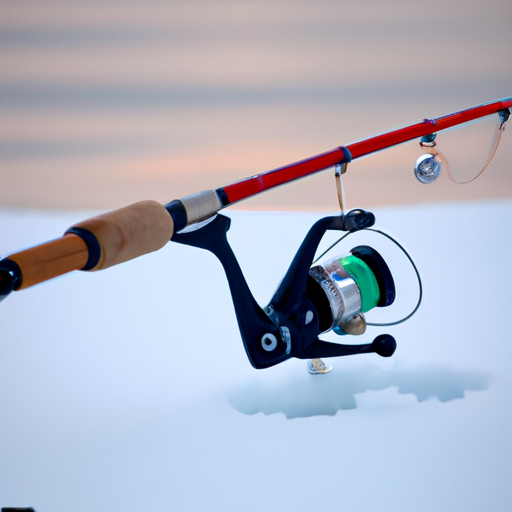
Identifying Winter Fishing Regulations
Checking for seasonal fishing closures
Before embarking on winter bass fishing, check for any seasonal fishing closures that may be in place. Some bodies of water have specific periods during which fishing is prohibited to protect fish populations during sensitive times, such as spawning seasons. Familiarize yourself with local regulations and closures to ensure you fish in permitted areas and during the appropriate times.
Knowing catch limits and size restrictions
Be aware of the catch limits and size restrictions in your area when winter bass fishing. Different regions have specific regulations in place to promote sustainable fishing practices and protect fish populations. Understand the minimum size requirements for keeping bass and the daily or possession limits. Respecting these regulations helps preserve the bass population and ensures future fishing opportunities.
Familiarizing with local fishing regulations
Familiarize yourself with local fishing regulations beyond catch limits and size restrictions. Different areas may have additional rules regarding fishing methods, bait types, or specific fishing seasons. Ensure compliance with these regulations by obtaining the necessary information from local fishing authorities or through online resources. Staying informed and adhering to local regulations demonstrates respect for the environment and the fishery.
Obtaining necessary fishing licenses
Obtaining a fishing license is a legal requirement in most areas. Before engaging in winter bass fishing, ensure you have the necessary fishing license or permit. Licenses can typically be purchased online or at local fishing tackle shops. Make sure your fishing license is valid for the specific region and time period you plan to fish in. Fishing without a proper license can result in fines and legal consequences.
Respecting conservation efforts
Respecting conservation efforts is crucial for sustainable winter bass fishing. Support and comply with any conservation practices implemented in your area. This may include catch and release programs, habitat restoration initiatives, or research projects. By participating and supporting these conservation efforts, you contribute to the preservation of bass populations and the overall health of the ecosystem.
Considering the Benefits of Winter Bass Fishing
Less fishing pressure and competition
One of the significant benefits of winter bass fishing is the reduced fishing pressure and competition. Many anglers shy away from fishing during the colder months, leaving plenty of untouched fishing opportunities. With fewer people on the water, you have a better chance of finding less pressured and more cooperative bass. Take advantage of this quieter period to enjoy a more serene fishing experience.
Opportunity for trophy-sized bass
Winter bass fishing offers a unique opportunity to target trophy-sized bass. Larger bass tend to become more active during winter months, making it a prime time to connect with a trophy fish. The chances of landing a personal best or a memorable catch increase as the cold temperatures encourage larger bass to feed and strike. Prepare for potentially epic battles and the possibility of hooking into a true giant.
Improving fishing skills and knowledge
Engaging in winter bass fishing can significantly improve your fishing skills and knowledge. With different techniques, altered feeding patterns, and challenging conditions, winter fishing requires adaptability and the exploration of new strategies. By fishing during this season, you’ll gain invaluable experience and develop a deeper understanding of bass behavior throughout the year. Learn from each outing and use these lessons to enhance your overall fishing skills.
Enjoying the tranquility of winter landscapes
Winter bass fishing provides an opportunity to immerse yourself in the tranquility of winter landscapes. The stillness of frozen lakes, serene snow-covered banks, and the absence of summer crowds create a peaceful and serene fishing environment. The beauty of winter scenery paired with the excitement of catching bass makes for a truly unique and rejuvenating fishing experience.
Appreciating the unique experience of winter fishing
Winter bass fishing offers an experience that is vastly different from other fishing seasons. It requires a different mindset, different techniques, and a willingness to adapt. Embrace the challenge and appreciate the uniqueness of winter fishing. The memories and stories created during these fishing adventures become cherished moments that highlight the diversity and richness of the angling world. So bundle up, head out to the water, and embrace the magic of winter bass fishing.



